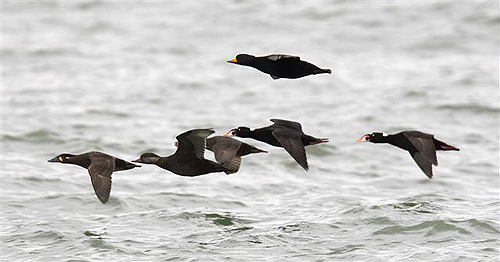 |
| Black and Surf Scoters (photo: Sampo Laukkanen). |
Introduction
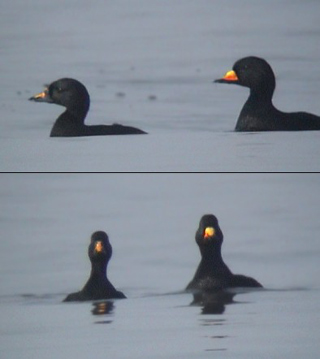 |
| Common and Black Scoter: Denmark, March Note bulkier-looking Black Scoter (right-hand bird) with thicker neck as well as diagnostic differences in bill structure and colour patterns (photo: Ole Krogh). |
In the UK there have been six records (see latest BBRC report) of this recently split species — all adult males. You have to believe that some female and immature male Black Scoters are slipping through the net of rarity-finding eyes in the UK. So, I will endeavour to present a full picture of how to be ready when the opportunity comes along of nailing a more subtly plumaged Black Scoter, as well as being watertight on the identification of adult males. Recently, the possibility of how easy it would be to overlook a 1st-winter male Black Scoter became clear when I went to see a 'female' Common Scoter which had been present on a local lake in South Yorkshire for about a week. The bird was not far offshore and it quickly became apparent that it was in fact a 1st-winter male Common Scoter. The subtle features, such as the apparent dull grey-green on the bill mirroring the pattern of orangey-yellow on adult males, is exactly the kind of feature reflected in identifying 1st-winter male Black Scoters, but which could also be so easily overlooked. Frankly, this bird could have been an identifiable young male Black Scoter and gone unclaimed as such.
My early knowledge of Scoters was limited to the trio of Common Scoter, Velvet Scoter and the rare Surf Scoter. In Cheshire, seeing any scoter was a matter of occasional flight views on a seawatch off the Wirral, or the hope of a storm-blown individual. I had to travel to Norfolk in the late 70s to see my first Velvet through someone else's Hertel and Reuss telescope, and even that was not much more than a white wing flash in a raft of black dots. After a failed attempt in Scotland, it took a trip to Ireland in the early 1980s to see Surf Scoter. It would be easy to conclude, in the UK at least, that scoters are more inclined to bring more frustration than inspiration! On occasion though they can perform very well indeed. In February 1979 a particularly cold snap brought an obliging male Common Scoter, which shared Southport Marine Lake with a Black-throated Diver. This individual had what seemed an exceptional amount of orange and yellow on the bill and through pondering the appearance of this bird this I became conscious of the North American (then subspecies of) Black Scoter.
Summary of Scoter Taxonomy
The recent announcement by the BOURC that it is splitting some of the former subspecies into species gives a great opportunity to parade the beauty of scoters in all their variety. There are in fact not three but six distinctly different types of scoter; they all have the potential to occur in Britain and Ireland and it seems likely that all six will eventually be elevated to species status. So it's worth being prepared for those special occasions when scoters afford good views. Firstly, a quick review of the taxonomy.
In a paper published back in 1914 Henry Thurston illustrated not three but six species of Scoter (see Dwight 1914). Under the genus of Oidemia the six recognized species were:
- Oidemia americana = Black Scoter
- Oidemia nigra = Common Scoter
- Oidemia fusca = Velvet Scoter
- Oidemia deglandi = White-winged Scoter or American White-winged Scoter
- Oidemia stejnegeri = Stejneger's Scoter or Asian White-winged Scoter
- Oidemia perspicillata = Surf Scoter
Since then the genus has changed to Melanitta and in the 'west' the six species were lumped into three species during the early/middle part of the 20th century. With some bird forms there have been genuine discoveries in the last couple of decades about biology, behaviour and characteristics (including molecular data) that have caused an elevation of a former subspecies to species status. Examples such as Taiga Flycatcher, Balearic Shearwater and Hume's Warbler all spring to mind. However, some taxonomic changes are more of a pendulum-swing, reflecting current trends rather than new information, and this is certainly the case with the scoters. Past authors such as Dwight fully recognized the very significant differences in bill structures, feathering around the bill base and some plumage differences that caused them to see specific status for these birds as axiomatic. In the recent splits of Black Scoter and American White-winged Scoter, the criteria are almost exactly the same as those evident in Dwight (save for difference in courtship call between Common and Black Scoters).
I think if I were a Russian ornithologist I would feel a degree of frustration too. Arguably they are better placed to make taxonomic decisions about these birds as they co-occur within their geographic region. The Russians have had the splits currently being announced by the BOURC in place for many years. Here is how the taxonomic situation currently looks under the BOURC:
- Melanitta americana = Black Scoter
- Melanitta nigra = Common Scoter
- Melanitta fusca = Velvet Scoter
- Melanitta deglandi (with subspecies deglandi and stejnegeri) = American and Asian White-winged/Stejneger's Scoter
- Melanitta perspicillata = Surf Scoter
There is no new information that has spawned the split of the White-winged Scoter, and as the form stejnegeri already fulfils key criteria proposed by the BOURC for recognizing species, its upgrade (again!) to full species status seems highly likely.
In this article though I will only cover the identification of Black Scoter. It was not long ago that only adult males were considered identifiable in a UK context. Indeed, the six records so far in Britain have all been of adult males, with no records yet from Ireland. Following excellent short papers by Alderfer (1992) and Waring (1993), it became increasingly clear that some examples of females and immatures should be identifiable too. It will take clued-up observers making the most of close views, so for those inspired to try, here is an analysis of some of the key characters to look for.
Adult Male Black Scoter
 |
| Adult male Common and Black Scoters: Adult males showing differences in bill structure and general distribution of orange and yellow tones on the bill. The Common Scoter is an example of the maximum amount of colour over basal knob (of the type most likely to be confused with Black Scoter). Many have much less yellow/orange patterning than this (sketch: Martin Garner). |
I went to see the adult male Black Scoter in St Bride's Bay, Dyfed in January 1992. At the time it represented only the 5th British record of a bird I had long wanted to see in the UK. It was in the company of a couple of hundred Common Scoters and I ended up having fantastic views of this individual. It showed quite a number of interesting differences from the Common Scoters, both in plumage and behaviour, which subsequently inspired me to look even more carefully at these birds in Canada. The most important and well-known difference is in the shape and colour of the pattern on the bill. Black Scoters are also known colloquially by the descriptive names of 'butterbill' and 'coppernose', due to the yellow and orange 'globe' that seems to be stuck on the base of a flat black mandible.
Adult male Common Scoter has a black bill, with the 'knobbly bit' right at the top of the bill base. The pattern and colour on a Common Scoter's bill is typically of yellow over the flat section of the upper mandible, extending in a thin line up and over the basal knob. On some males this can be much more extensive, virtually covering the basal knob with orange in a head-on view, thus becoming more similar in appearance to the Black Scoter (BWP suggests these are young/2nd calendar-year males). Note, however, there is always black on the sides of the basal knob on Common Scoter. However, most scoters do not come close enough to see these details well enough. When watching birds bobbling about at some distance on the sea, many male Common Scoters can appear to show big yellow patches at the base of the bill, which can mimic the appearance of male Black Scoter...it's very easy to be fooled!
 |
| Adult male Common and Black Scoters: Adult males showing differences of head and bill profile (sketch: Martin Garner). |
Watching the Dyfed Black Scoter I noticed straightaway that it sat higher on the water, showing more body than the Common Scoters, in effect making it look a little larger. It also cocked its tail more frequently than the male Common Scoters, and the tail was clearly shorter than its companions. One of the most striking features was a distinctive behavioural characteristic. Watching the male Black Scoter in the scoter flock it suddenly decided to leave the flock, which was a couple of 100 yards out, and head straight for the shore by itself. It proceeded to swim all the way to the breaking surf and feed, by diving for several minutes before returning to the flock. To confirm this was not just a one-off action, it repeated this behaviour several times during a three-hour period of watching. I have since noted in Canada that Black Scoter often enjoy feeding close inshore, much more so than their European counterparts. While the bird of recent winters in North Wales may not have been so obliging, I still think that any approachable or surf-feeding Scoter is worth double-checking. In North America another generic name for all scoters, which reflects their behaviour over there, is 'Surf Duck'.
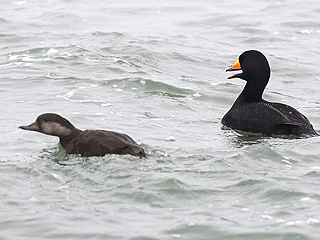 |
 |
| Black Scoter: USA, March Both of these birds are identifiably different from Common Scoter, though the female is particularly subtle in its features! (see text) (photo: Sampo Laukkanen). | Black Scoter: USA, March The bright orange and yellow globe on the bill of the male is diagnostic. On the female it is possible to make out the rather lumpy bill profile and, especially, a bit of yellow on the bill sides which should make such a female identifiable in the UK (photo: Sampo Laukkanen). |
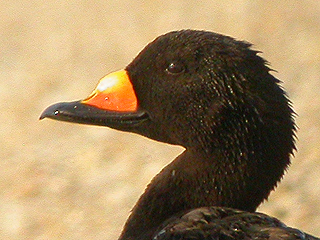 |
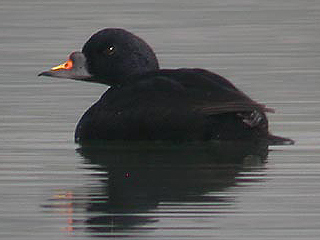 |
| Black Scoter: Cape May, August Adult male (photo: Paul and Andrea Kelly). | Common Scoter: Leicestershire, March Adult male (photo: Rob Fray). |
Key features of adult male Black Scoter
- Prominent yellow-orange 'globe' stuck on bill base, with no black at sides of the 'globe'
- Orange colour tends to be in lower section of 'globe' (orange often in upper section or spread all over in Common Scoter)
- Sits higher on water and looks bulkier than Common Scoter
- Thicker-necked
- Shorter-tailed
- Penchant for feeding in, or near, the surf
- Eye-ring tends to be bluish-grey not yellow
- Bill tip with more prominent nail, and nostrils nearer bill base, though the only really useful feature in the field is the prominent nail
1st winter male Black Scoter
 |
| Black Scoter in female and immature plumages (sketch: Martin Garner). |
 |
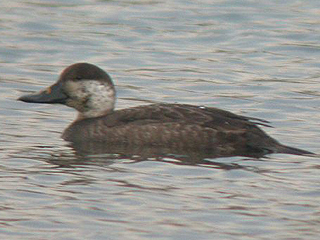 |
| 1st-winter male Common Scoter: South Yorkshire, November The dull grey-green patch on the bill is just visible and is the beginning of what will become the orange/yellow in adult male plumage (photo: Martin Garner). | 1st-winter male Common Scoter: South Yorkshire, November Harder to age in profile, with a small amount of black feathering emerging in the paler cheek area (photo: Martin Garner). |
My own experience of birds in this plumage is limited to November and December. However, as this is one of the peak times of discovery of Black Scoters in Western Europe, then the following observations may well be apposite! Black Scoters in first-winter plumage tend to look very female-like in late autumn and early winter, as the black feathering is only just beginning to show through. Indeed, moult timing of individual males can vary greatly, with some being quite adult-like in spring and others still hard to tell from females (Dwight 1914). However, one of the features I noted is that where the basal globe will appear, young males have a 'snot-green' (or for sensitive types a grey-green) or mustard-coloured patch. It is not easy to detect, as at a glance the bill can look uniformly greyish, but it becomes quite apparent if looked for and is a diagnostic difference as it mirrors the more readily recognisable adult character. I can well imagine that a first winter male Black Scoter occurring in the UK in November/December will be overlooked, except by those taking a careful second look for this grey-green or mustard-coloured patch. Later in the winter the patch becomes more yellow and more conspicuous and the presence black feathering (indicating a young male bird) makes identification increasingly easier.
Key features of 1st winter male Black Scoter
- Grey-green/mustard coloured patch over bill base in November/December becoming more yellow and conspicuous as winter progresses
- More prominent nail than Common
- Likely to show steeper forehead and squarer head shape than Common
- Possibly a different pattern of dark and light on head compared to Common Scoter (see description of females)
Female and juvenile Black Scoter
 |
| Female and juvenile Common and Black Scoters: Comparison of head and bill features (sketch: Martin Garner). |
I have closely examined a number of more obliging female/juvenile Common Scoters including an overnight 'expedition' to see four 'surf-feeding' birds in Co. Donegal. Whilst sceptics may argue that you can't identify this plumage of Black Scoter in the field, I would disagree. All of the birds that I have seen closely I have eventually been able to confirm to my satisfaction as female-type (including late moulting juvenile males) Common Scoters, due to a variety of subtle characters. I am confident that if a real female Black Scoter gave obliging views, than it should be identifiable. All of the key features are around the head and bill. The bill is a tad shorter on average than Common with a more swollen base and prominent 'hooked' nail. The whole effect of the bill in profile is 'lumpier' with a straight or bulging profile to the bill base and a prominent hooked nail. The head shape tends to be a little different with steeper forehead and domed crown, producing a squarer feel to the head.
 |
| Comparison of nape pattern of female/juvenile Common and Black Scoters (sketch: Martin Garner). |
 |
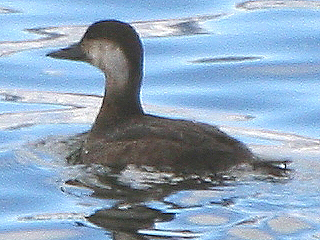 |
| 1st-winter male Common Scoter: South Yorkshire, November Notice tapered pattern of dark nape patch (photo: Martin Garner). | Female/immature Black Scoter: USA, December Notice the more extensive dark nape pattern that is of more even width throughout (photo: Glenn Walbek). |
The pattern of the dark cap is often more extensive on Black Scoter, being more visible on the nape sides in profile. By viewing the rear of the head, it is possible to see the dark cap extending down the nape. On Common Scoter this tends to come to a tapered point, whereas in Black Scoter it is more round-ended or 'squared-off'. I have not tested this sufficiently to note any degree of overlap, but I think it could be a useful feature in general. David Waring (Birding World 6, 78–79) noted that c. 10% of adult females in spring and summer can show extensive yellow markings on the bill. Some female Common Scoters can show some yellow in the nostril cavities and a smaller patch in the middle of the culmen, but otherwise do not show such extensive yellow. Juveniles of both species tend to have the palest cheeks, whilst typically on adult females the cheeks tend to be darker with dusky streaking throughout, contrasting less with the dark cap. Common Scoters in juvenile and female type plumages often show a dark smudgy curve extending vertically below the eye. This feature tends to be much less prominent on juvenile and female-type Black Scoters.
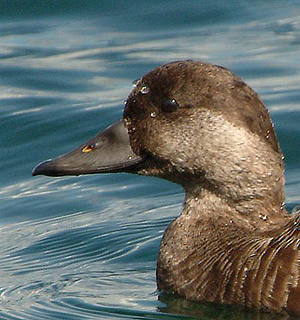 |
| Adult female Common Scoter: Lancashire, August Note the rather smooth bill profile without prominent hooked nail, and pattern of dark and light on head. Adult females have cheeks that are streaked with brown, thus slightly darker and less contrasting than in juvenile (see text) (photo: Stephen Tomlinson). |
Key features of juvenile and female Black Scoter
- Lumpier bill often with slightly swollen base and prominent hooked/arched nail
- Squarer head shape
- More dark patterning on sides of nape
- Dark cap may end on squared-off or broad rounded line on hindneck, not tapered as in Common
- 10% of adults females show extensive yellow on bill
- Cheeks tend to be cleaner (dark vertical cheek mark less obvious) than corresponding plumage in Common.
Hopefully, most of the more subtle features are apparent in the photographs and in some of my illustrations. The illustrations tend to exaggerate the features slightly to make the point (and I am no artist!) I firmly believe that the prize of finding more of these birds will fall to those who go the extra mile in checking and double-checking the scoters that give the close views.
References
Alderfer, J. 1992. Immature Black Scoters. Birding World 5: 193-4.
Cramp, S and Simmons, K.E.L. Eds. 1977. The Birds of the Western Palearctic. Vol: 1. Oxford.
Dwight, J. 1914. The Moults and Plumages of the Scoters, genus Oidemia (Melanitta). Auk 31: 293-308
Waring, D. 1993. Identification Forum: female Black Scoter. Birding World 6: 78-79.


